Hyundai Equus 2015 Repair Manual
Manufacturer: HYUNDAI, Model Year: 2015, Model line: Equus, Model: Hyundai Equus 2015Pages: 483, PDF Size: 13.26 MB
Page 61 of 483
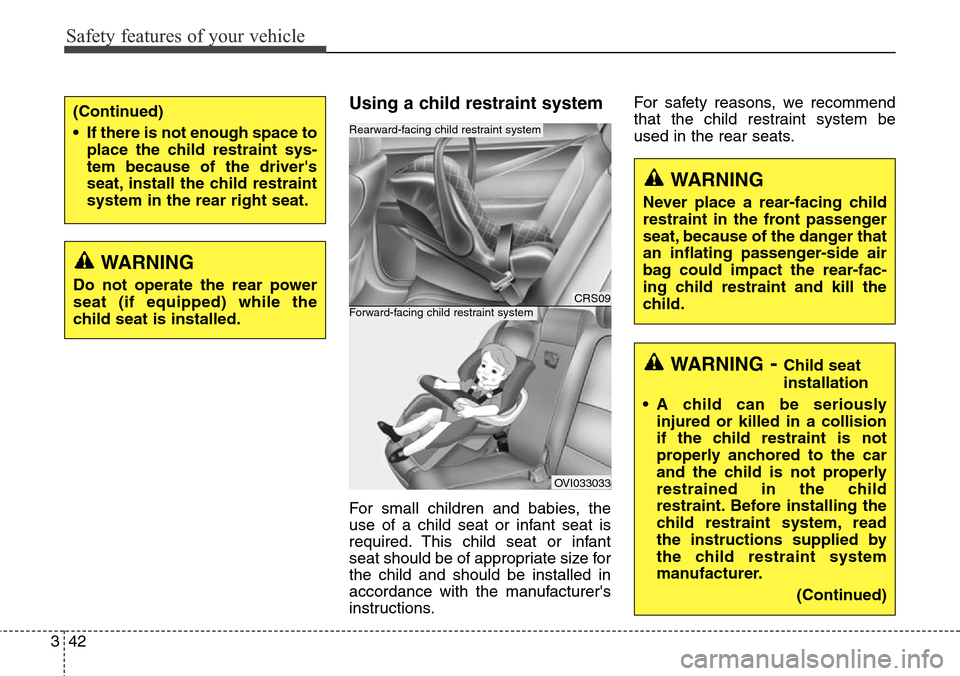
Safety features of your vehicle
42 3
Using a child restraint system
For small children and babies, the
use of a child seat or infant seat is
required. This child seat or infant
seat should be of appropriate size for
the child and should be installed in
accordance with the manufacturer's
instructions.For safety reasons, we recommend
that the child restraint system be
used in the rear seats.
CRS09
OVI033033
Forward-facing child restraint system
Rearward-facing child restraint system
WARNING
Do not operate the rear power
seat (if equipped) while the
child seat is installed.
WARNING
Never place a rear-facing child
restraint in the front passenger
seat, because of the danger that
an inflating passenger-side air
bag could impact the rear-fac-
ing child restraint and kill the
child.
(Continued)
• If there is not enough space to
place the child restraint sys-
tem because of the driver's
seat, install the child restraint
system in the rear right seat.
WARNING- Child seat
installation
• A child can be seriously
injured or killed in a collision
if the child restraint is not
properly anchored to the car
and the child is not properly
restrained in the child
restraint. Before installing the
child restraint system, read
the instructions supplied by
the child restraint system
manufacturer.
(Continued)
Page 62 of 483
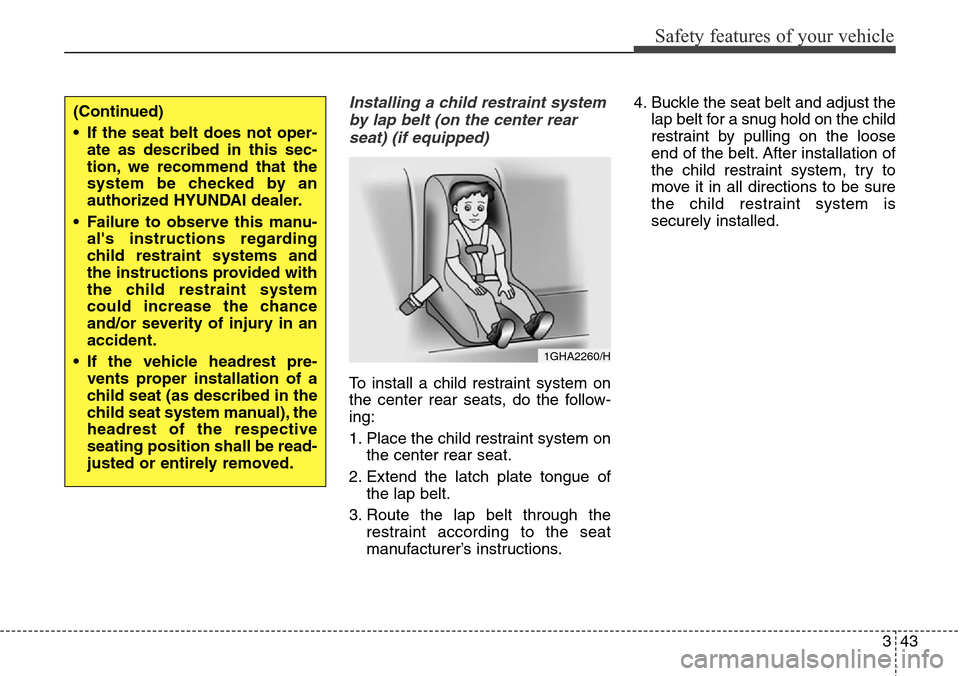
343
Safety features of your vehicle
Installing a child restraint system
by lap belt (on the center rear
seat) (if equipped)
To install a child restraint system on
the center rear seats, do the follow-
ing:
1. Place the child restraint system on
the center rear seat.
2. Extend the latch plate tongue of
the lap belt.
3. Route the lap belt through the
restraint according to the seat
manufacturer’s instructions.4. Buckle the seat belt and adjust the
lap belt for a snug hold on the child
restraint by pulling on the loose
end of the belt. After installation of
the child restraint system, try to
move it in all directions to be sure
the child restraint system is
securely installed.
1GHA2260/H
(Continued)
• If the seat belt does not oper-
ate as described in this sec-
tion, we recommend that the
system be checked by an
authorized HYUNDAI dealer.
• Failure to observe this manu-
al's instructions regarding
child restraint systems and
the instructions provided with
the child restraint system
could increase the chance
and/or severity of injury in an
accident.
• If the vehicle headrest pre-
vents proper installation of a
child seat (as described in the
child seat system manual), the
headrest of the respective
seating position shall be read-
justed or entirely removed.
Page 63 of 483
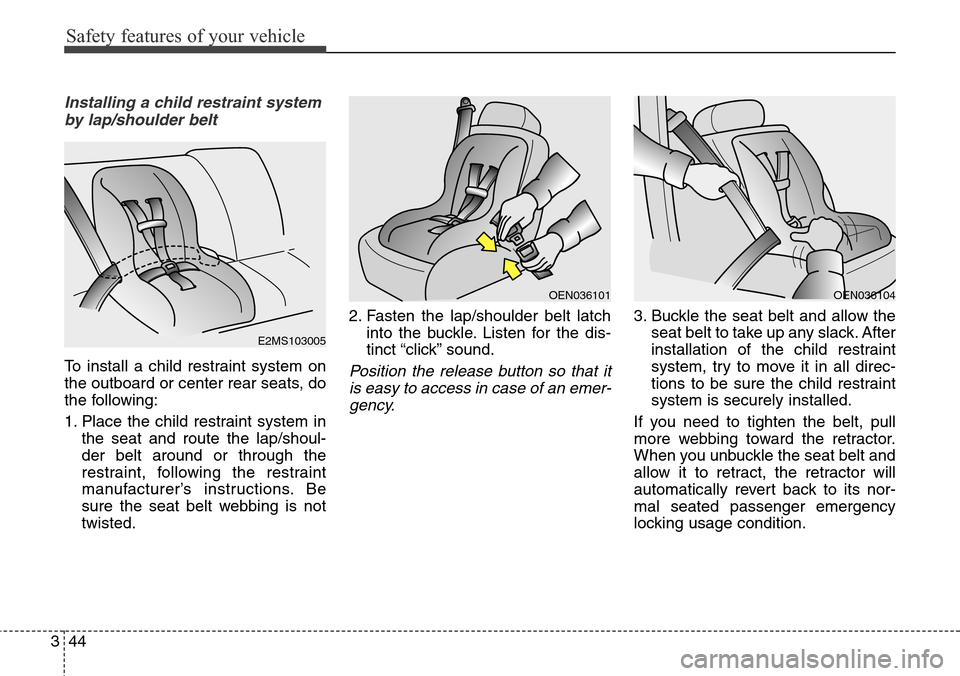
Safety features of your vehicle
44 3
Installing a child restraint system
by lap/shoulder belt
To install a child restraint system on
the outboard or center rear seats, do
the following:
1. Place the child restraint system in
the seat and route the lap/shoul-
der belt around or through the
restraint, following the restraint
manufacturer’s instructions. Be
sure the seat belt webbing is not
twisted.2. Fasten the lap/shoulder belt latch
into the buckle. Listen for the dis-
tinct “click” sound.Position the release button so that it
is easy to access in case of an emer-
gency.
3. Buckle the seat belt and allow the
seat belt to take up any slack. After
installation of the child restraint
system, try to move it in all direc-
tions to be sure the child restraint
system is securely installed.
If you need to tighten the belt, pull
more webbing toward the retractor.
When you unbuckle the seat belt and
allow it to retract, the retractor will
automatically revert back to its nor-
mal seated passenger emergency
locking usage condition.
OEN036101OEN036104
E2MS103005
Page 64 of 483
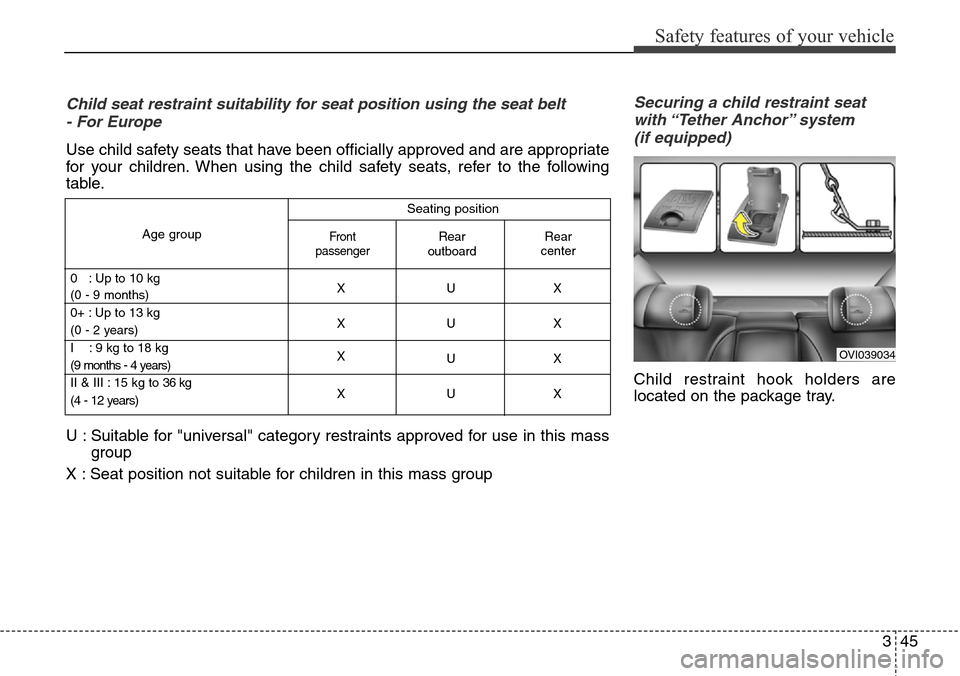
345
Safety features of your vehicle
Securing a child restraint seat
with “Tether Anchor” system
(if equipped)
Child restraint hook holders are
located on the package tray.
Seating position
Age group
0 : Up to 10 kg
XUX
(0 - 9 months)
0+ : Up to 13 kg
XUX
(0 - 2 years)
I : 9 kg to 18 kg
X
UX(9 months - 4 years)
II & III : 15 kg to 36 kg
XUX
(4 - 12 years)
Front
passengerRear
outboardRear
center
Child seat restraint suitability for seat position using the seat belt
- For Europe
Use child safety seats that have been officially approved and are appropriate
for your children. When using the child safety seats, refer to the following
table.
OVI039034
U : Suitable for "universal" category restraints approved for use in this mass
group
X : Seat position not suitable for children in this mass group
Page 65 of 483
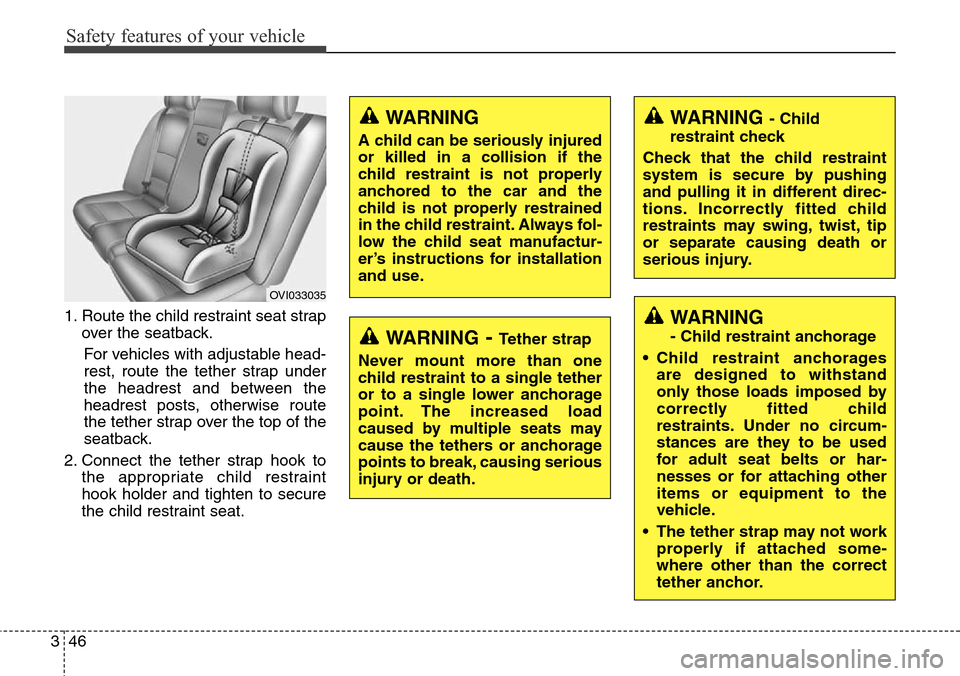
Safety features of your vehicle
46 3
1. Route the child restraint seat strap
over the seatback.
For vehicles with adjustable head-
rest, route the tether strap under
the headrest and between the
headrest posts, otherwise route
the tether strap over the top of the
seatback.
2. Connect the tether strap hook to
the appropriate child restraint
hook holder and tighten to secure
the child restraint seat.
OVI033035
WARNING- Tether strap
Never mount more than one
child restraint to a single tether
or to a single lower anchorage
point. The increased load
caused by multiple seats may
cause the tethers or anchorage
points to break, causing serious
injury or death.
WARNING
A child can be seriously injured
or killed in a collision if the
child restraint is not properly
anchored to the car and the
child is not properly restrained
in the child restraint. Always fol-
low the child seat manufactur-
er’s instructions for installation
and use.
WARNING - Child
restraint check
Check that the child restraint
system is secure by pushing
and pulling it in different direc-
tions. Incorrectly fitted child
restraints may swing, twist, tip
or separate causing death or
serious injury.
WARNING
- Child restraint anchorage
• Child restraint anchorages
are designed to withstand
only those loads imposed by
correctly fitted child
restraints. Under no circum-
stances are they to be used
for adult seat belts or har-
nesses or for attaching other
items or equipment to the
vehicle.
• The tether strap may not work
properly if attached some-
where other than the correct
tether anchor.
Page 66 of 483
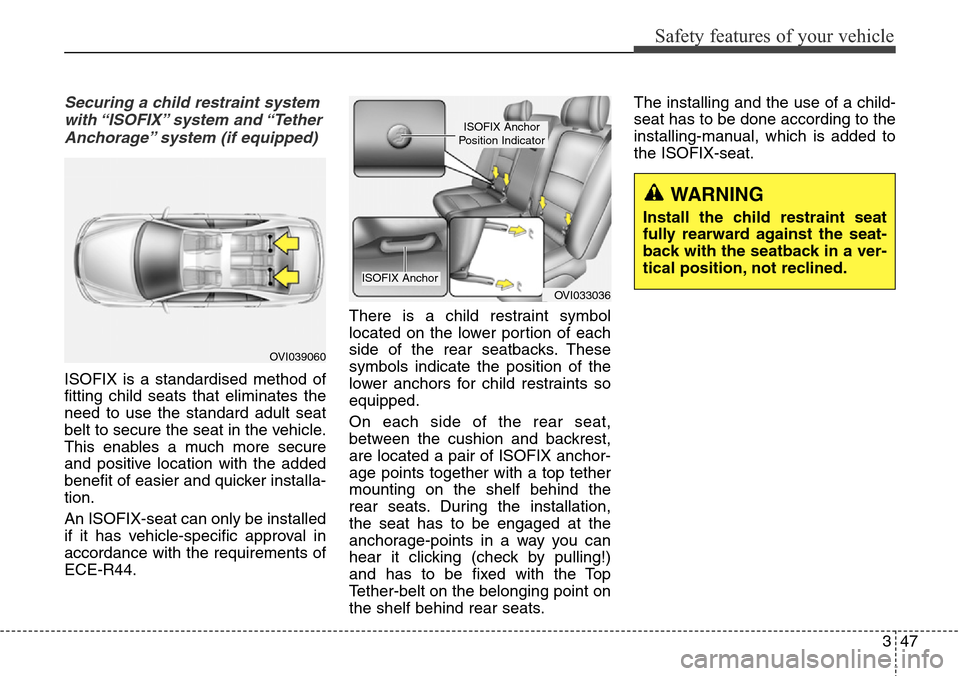
347
Safety features of your vehicle
Securing a child restraint system
with “ISOFIX” system and “Tether
Anchorage” system (if equipped)
ISOFIX is a standardised method of
fitting child seats that eliminates the
need to use the standard adult seat
belt to secure the seat in the vehicle.
This enables a much more secure
and positive location with the added
benefit of easier and quicker installa-
tion.
An ISOFIX-seat can only be installed
if it has vehicle-specific approval in
accordance with the requirements of
ECE-R44.There is a child restraint symbol
located on the lower portion of each
side of the rear seatbacks. These
symbols indicate the position of the
lower anchors for child restraints so
equipped.
On each side of the rear seat,
between the cushion and backrest,
are located a pair of ISOFIX anchor-
age points together with a top tether
mounting on the shelf behind the
rear seats. During the installation,
the seat has to be engaged at the
anchorage-points in a way you can
hear it clicking (check by pulling!)
and has to be fixed with the Top
Tether-belt on the belonging point on
the shelf behind rear seats.The installing and the use of a child-
seat has to be done according to the
installing-manual, which is added to
the ISOFIX-seat.
OVI039060
OVI033036
ISOFIX Anchor
ISOFIX Anchor
Position Indicator
WARNING
Install the child restraint seat
fully rearward against the seat-
back with the seatback in a ver-
tical position, not reclined.
Page 67 of 483
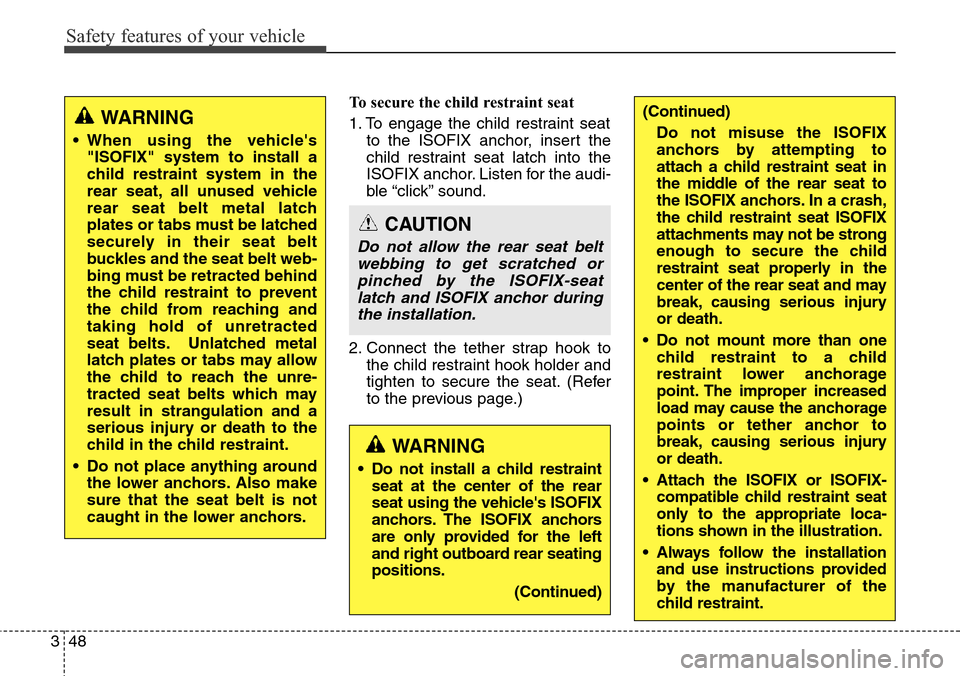
Safety features of your vehicle
48 3
To secure the child restraint seat
1. To engage the child restraint seat
to the ISOFIX anchor, insert the
child restraint seat latch into the
ISOFIX anchor. Listen for the audi-
ble “click” sound.
2. Connect the tether strap hook to
the child restraint hook holder and
tighten to secure the seat. (Refer
to the previous page.)
WARNING
• When using the vehicle's
"ISOFIX" system to install a
child restraint system in the
rear seat, all unused vehicle
rear seat belt metal latch
plates or tabs must be latched
securely in their seat belt
buckles and the seat belt web-
bing must be retracted behind
the child restraint to prevent
the child from reaching and
taking hold of unretracted
seat belts. Unlatched metal
latch plates or tabs may allow
the child to reach the unre-
tracted seat belts which may
result in strangulation and a
serious injury or death to the
child in the child restraint.
• Do not place anything around
the lower anchors. Also make
sure that the seat belt is not
caught in the lower anchors.
CAUTION
Do not allow the rear seat belt
webbing to get scratched or
pinched by the ISOFIX-seat
latch and ISOFIX anchor during
the installation.
(Continued)
Do not misuse the ISOFIX
anchors by attempting to
attach a child restraint seat in
the middle of the rear seat to
the ISOFIX anchors. In a crash,
the child restraint seat ISOFIX
attachments may not be strong
enough to secure the child
restraint seat properly in the
center of the rear seat and may
break, causing serious injury
or death.
• Do not mount more than one
child restraint to a child
restraint lower anchorage
point. The improper increased
load may cause the anchorage
points or tether anchor to
break, causing serious injury
or death.
• Attach the ISOFIX or ISOFIX-
compatible child restraint seat
only to the appropriate loca-
tions shown in the illustration.
• Always follow the installation
and use instructions provided
by the manufacturer of the
child restraint.
WARNING
• Do not install a child restraint
seat at the center of the rear
seat using the vehicle's ISOFIX
anchors. The ISOFIX anchors
are only provided for the left
and right outboard rear seating
positions.
(Continued)
Page 68 of 483
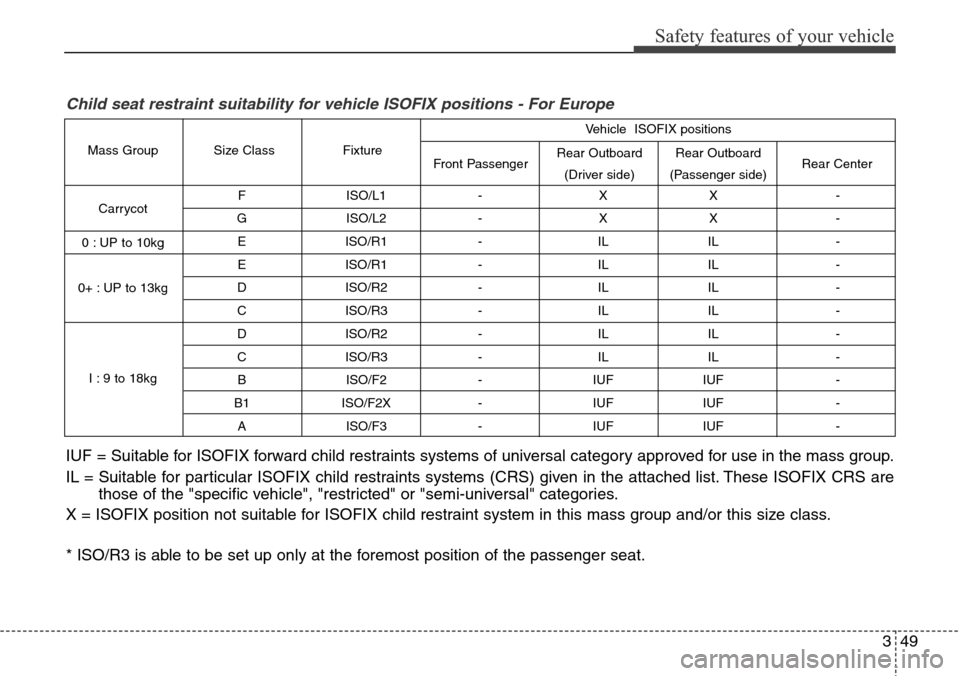
349
Safety features of your vehicle
F ISO/L1 - X X -
G ISO/L2 - X X -
E ISO/R1 - IL IL -
E ISO/R1 - IL IL -
D ISO/R2 - IL IL -
C ISO/R3 - IL IL -
D ISO/R2 - IL IL -
C ISO/R3 - IL IL -
B ISO/F2 - IUF IUF -
B1 ISO/F2X - IUF IUF -
A ISO/F3 - IUF IUF -
Rear Outboard
(Passenger side) Rear Outboard
(Driver side) Front Passenger Fixture Size Class Mass Group
Carrycot
0 : UP to 10kg
0+ : UP to 13kg
I : 9 to 18kgRear Center Vehicle ISOFIX positions
IUF = Suitable for ISOFIX forward child restraints systems of universal category approved for use in the mass group.
IL = Suitable for particular ISOFIX child restraints systems (CRS) given in the attached list. These ISOFIX CRS are
those of the "specific vehicle", "restricted" or "semi-universal" categories.
X = ISOFIX position not suitable for ISOFIX child restraint system in this mass group and/or this size class.
* ISO/R3 is able to be set up only at the foremost position of the passenger seat.
Child seat restraint suitability for vehicle ISOFIX positions - For Europe
Page 69 of 483
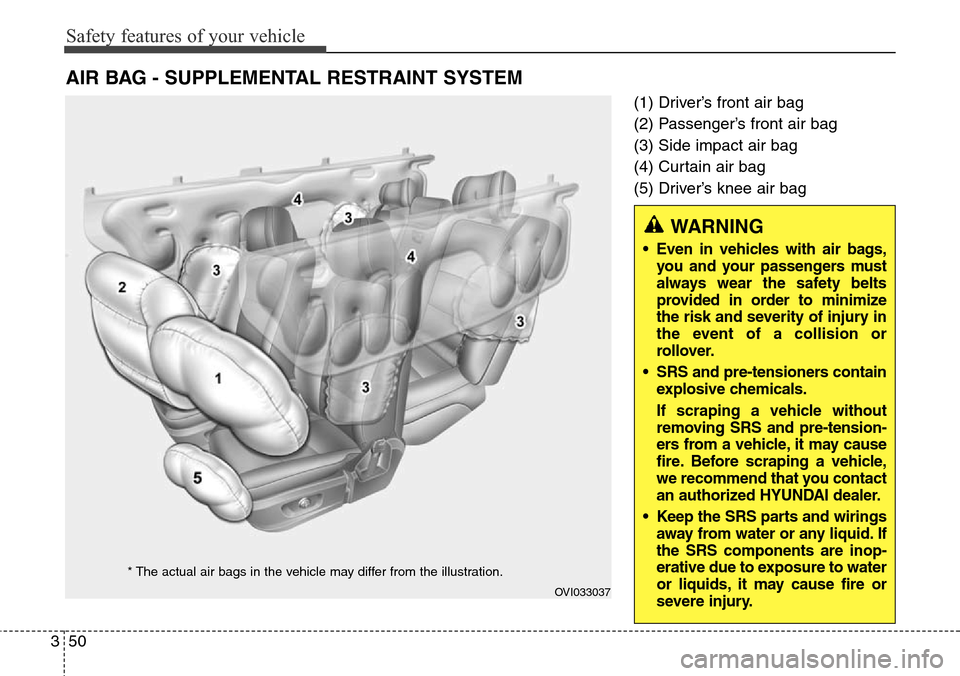
Safety features of your vehicle
50 3
(1) Driver’s front air bag
(2) Passenger’s front air bag
(3) Side impact air bag
(4) Curtain air bag
(5) Driver’s knee air bag
AIR BAG - SUPPLEMENTAL RESTRAINT SYSTEM
OVI033037
* The actual air bags in the vehicle may differ from the illustration.
WARNING
• Even in vehicles with air bags,
you and your passengers must
always wear the safety belts
provided in order to minimize
the risk and severity of injury in
the event of a collision or
rollover.
• SRS and pre-tensioners contain
explosive chemicals.
If scraping a vehicle without
removing SRS and pre-tension-
ers from a vehicle, it may cause
fire. Before scraping a vehicle,
we recommend that you contact
an authorized HYUNDAI dealer.
• Keep the SRS parts and wirings
away from water or any liquid. If
the SRS components are inop-
erative due to exposure to water
or liquids, it may cause fire or
severe injury.
Page 70 of 483
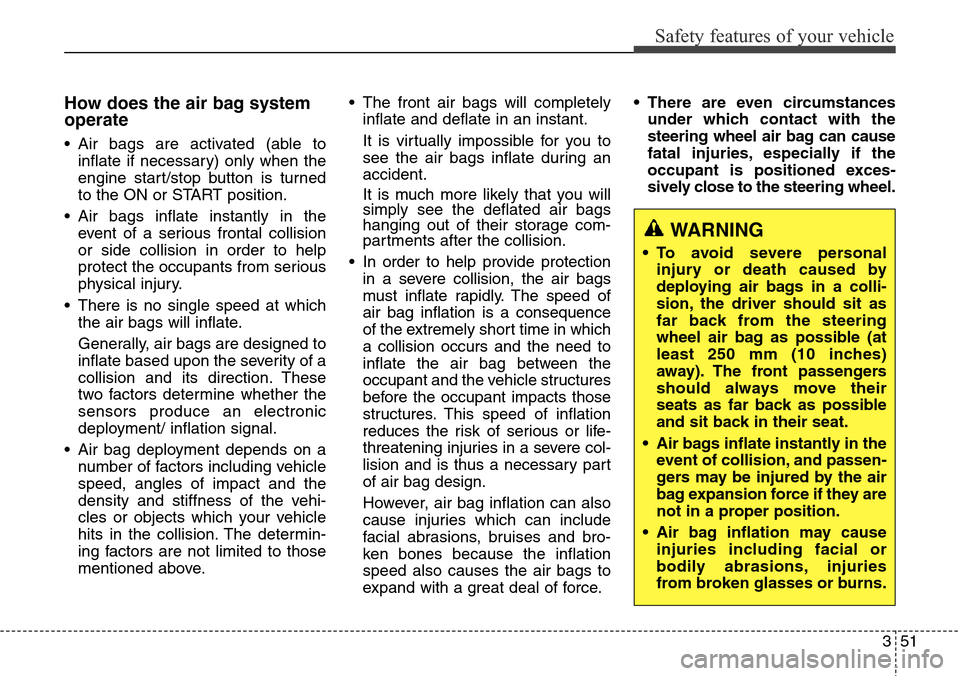
351
Safety features of your vehicle
How does the air bag system
operate
• Air bags are activated (able to
inflate if necessary) only when the
engine start/stop button is turned
to the ON or START position.
• Air bags inflate instantly in the
event of a serious frontal collision
or side collision in order to help
protect the occupants from serious
physical injury.
• There is no single speed at which
the air bags will inflate.
Generally, air bags are designed to
inflate based upon the severity of a
collision and its direction. These
two factors determine whether the
sensors produce an electronic
deployment/ inflation signal.
• Air bag deployment depends on a
number of factors including vehicle
speed, angles of impact and the
density and stiffness of the vehi-
cles or objects which your vehicle
hits in the collision. The determin-
ing factors are not limited to those
mentioned above.• The front air bags will completely
inflate and deflate in an instant.
It is virtually impossible for you to
see the air bags inflate during an
accident.
It is much more likely that you will
simply see the deflated air bags
hanging out of their storage com-
partments after the collision.
• In order to help provide protection
in a severe collision, the air bags
must inflate rapidly. The speed of
air bag inflation is a consequence
of the extremely short time in which
a collision occurs and the need to
inflate the air bag between the
occupant and the vehicle structures
before the occupant impacts those
structures. This speed of inflation
reduces the risk of serious or life-
threatening injuries in a severe col-
lision and is thus a necessary part
of air bag design.
However, air bag inflation can also
cause injuries which can include
facial abrasions, bruises and bro-
ken bones because the inflation
speed also causes the air bags to
expand with a great deal of force.• There are even circumstances
under which contact with the
steering wheel air bag can cause
fatal injuries, especially if the
occupant is positioned exces-
sively close to the steering wheel.
WARNING
• To avoid severe personal
injury or death caused by
deploying air bags in a colli-
sion, the driver should sit as
far back from the steering
wheel air bag as possible (at
least 250 mm (10 inches)
away). The front passengers
should always move their
seats as far back as possible
and sit back in their seat.
• Air bags inflate instantly in the
event of collision, and passen-
gers may be injured by the air
bag expansion force if they are
not in a proper position.
• Air bag inflation may cause
injuries including facial or
bodily abrasions, injuries
from broken glasses or burns.